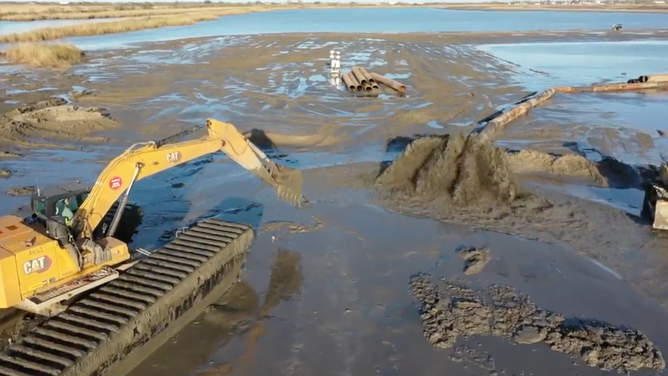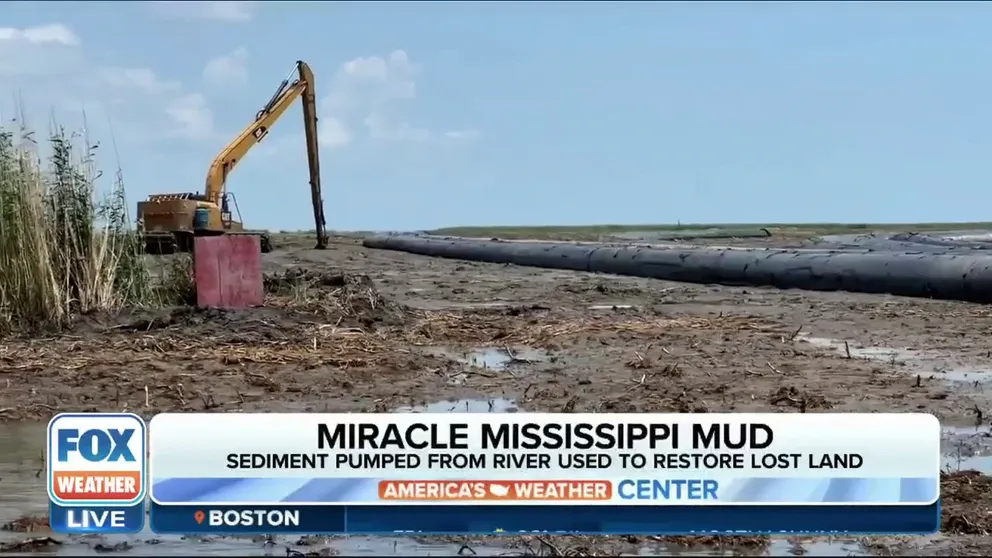Saving Coastal Louisiana: A $50 billion-5-decade-long plan to restore marshlands
The restoration work is ongoing at the mouth of the Mississippi River in an area known as the Spanish Pass. Only 2 years ago, the area was covered by open water.
A $50 billion plan to save Louisiana's marshlands
One of the largest coastal restoration projects in the world is happening on coastal Louisiana where a $50-billion-50-year plan is underway to restore lost marshlands. FOX Weather Correspondent Robert Ray reports from Louisiana.
VENICE, Louisiana – Coastal Louisiana is unlike anywhere else in America, with lush wetlands, wildlife sanctuaries, commercial fisheries and the mighty Mississippi River. It’s an economic engine - a gateway delivering commodities and goods across the planet.
Hurricanes and tropical storms have been smashing through the marshes and wetlands for as long as humans have been recording the disruptive weather events.
At the Louisiana State University River Center in Baton Rouge, scientists are studying the seriousness of erosion.
"These coastal wetlands have been disappearing what that means basically is the Gulf of Mexico is marching closer to us by the minute by the hour," said James Karst with the Coalition to Restore Coastal Louisiana.
Since the 1930s, Louisiana has lost about 2,000 square miles of coastal wetlands.
"It's a resilient ecosystem, but it's also a fragile ecosystem," said Bren Haase with Coastal Protection & Restoration Authority.
There is a $50 billion plan to restore the coastal marshes over 50 years. It’s considered one of the world's most ambitious coastal restoration plans.
"That's designed to provide a sustainable coastal Louisiana," Haase said. "We're not going to save our entire footprint as it exists today, but we do believe we can provide a sustainable coast that supports all of the culture and the recreation, the tourism on the economy."
The restoration work is ongoing at the mouth of the Mississippi River, known as the Spanish Pass. FOX Weather Correspondent Robert Ray traveled to Venice, Louisiana, to reach the work site.

Scenes of the work being done on Louisiana's coast to restore marshlands. (Image: Robert Ray/FOX Weather)
(FOX Weather)
‘IT UNRAVELS FROM THE BOTTOM’: SCIENTISTS WORK TO SAVE LOUISIANA'S SHRINKING WETLANDS
Gliding across wetlands in nearly 100-degree heat, Ray took an airboat to see the massive restoration project about 7 miles into the Gulf of Mexico. Only two years ago, the area was covered by open water. Now, sediment and mud rocks make up a human-made piece of marsh covering the vast space.
"This specific cell was more broken marsh than the rest of them. Some of them were more open water than anything, but behind me was you could see a good chunk of open water and just some broken pieces of marsh as the big storm surge comes in this breaks that large wave," said Barry Richard, with the Coastal Protection & Restoration Authority, pointing to the new marshlands.
Getting back on the airboat, the work further down the coast includes heavy equipment used to create and flatten new lands.

Scenes of the work being done on Louisiana's coast to restore marshlands. (Image: Robert Ray/FOX Weather)
(FOX Weather)
SATELLITE IMAGES REVEAL DRAMATIC LOSS OF LOUISIANA'S WETLANDS
Nearly 2,000 acres have been restored by pumping sand, mud and sediment from the Mississippi River. The Spanish Pass Project restored over 6 miles of the ridge and built over 1,6000 acres of marshlands.
Many of these projects are funded with Deepwater Horizon oil spill settlement funds implemented through the Natural Resource Damage Assessment Act. However, that money will not cover the entire 50-year project.
"It's also important for us here in New Orleans because these wetlands provide a buffer against hurricanes. They help to absorb storm surge, and what I often say is that the more land or, the more anything that a hurricane will pass over, the weaker it tends to be when it reaches populated areas like this," said James Karst with Coalition to Restore Coastal Louisiana.
